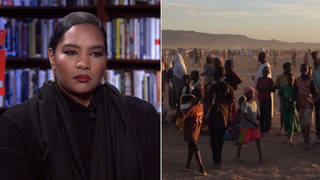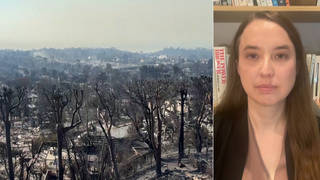
Topics
Guests
- Ken Pimlottdirector of the California Department of Forestry and Fire Protection and a 30-year fire service veteran.
Wildfires are raging up and down the state of California. At least two people have died, and hundreds of homes have been destroyed. We speak to Ken Pimlott, the director of the California Department of Forestry and Fire Protection and a 30-year fire service veteran. He joins us from Sacramento, where temperatures hit 107 degrees on Monday, one degree shy of the record.
Transcript
AMY GOODMAN: In addition to Professor Michael Mann, we’re joined by Ken Pimlott, who is director of the California Department of Forestry and Fire Protection. Can you talk about where in California these fires are raging? Where is the Erskine fire? And what’s happening?
KEN PIMLOTT: Yes. Good morning. The Erskine fire is in Kern County, which is in the south end of the San Joaquin Valley, just north of Los Angeles. And many of the rest of the fires—we have about eight fires, large fires, burning right now. The majority of those are in the southern half of the state. But conditions are changing throughout the state as we speak. The heat wave that Dr. Mann talked about is rapidly drying the vegetation throughout California, and so our fire activity is increasing throughout the state. Just last week, we had almost 300 new fires, those initial attack fires that we’re aggressively fighting every day. And that—so that count of fires every day is going up. And several of those fires then are escaping that initial attack and becoming these larger fires that we’re seeing. And so, really, no real relief from the heat wave. We anticipate these well-above-normal temperatures to continue for the days to come. And again, that’s just already—it’s parching already parched fuel, drying that down even more. And again, we’re really getting into peak fire season conditions right now.
AMY GOODMAN: How do these fires compare to—what—oh, the last 30 years?
KEN PIMLOTT: Yeah, what we’re seeing is several things. The most damaging fires—actually, about half of the state’s largest, most damaging fires have occurred just in about the last decade. And so, we’re seeing a significant change. Fire seasons may ebb and flow from year to year, but the trend is larger, more damaging fires and more acres burned.
AMY GOODMAN: And can you talk about the connection of the five-year drought that’s been going on in California?
KEN PIMLOTT: The connection of the drought to the conditions and the fire activity we’re seeing is profound. Again, five years of well-below-normal precipitation has left not just the dead vegetation, but, you know, the living fuels, very dry. And even some of the rainfall that we received this last winter was not enough to really change the conditions of the vegetation. It helped maybe prolong winter period a little bit this year. But now these hot conditions have dried the vegetation right back down to where it was. And what we’re seeing are fires burn at just exponential rates. Last year, we had two of the state’s top 10 most damaging fires in our history, and they were burning at rates that 30-year veteran firefighters haven’t seen. In one afternoon last year, we had a fire—you know, over 20,000 acres in just five hours. In 2014, the King fire near Lake Tahoe burned, you know, 15 miles in one afternoon. And so these fires are burning with intensities and at rates of spread that are really unprecedented.
AMY GOODMAN: And the temperature right now—for example, Sacramento, what, it’s like 105 degrees?
KEN PIMLOTT: Yes. And that’s statewide. We’re seeing—we may not be breaking records every day, but we’re certainly well above normal throughout the state. And we’re flirting with 100 degrees in many locations, or more, throughout the state. I believe Redding, in the north half of the state, will be reaching 108 degrees a little bit later this week.













Media Options